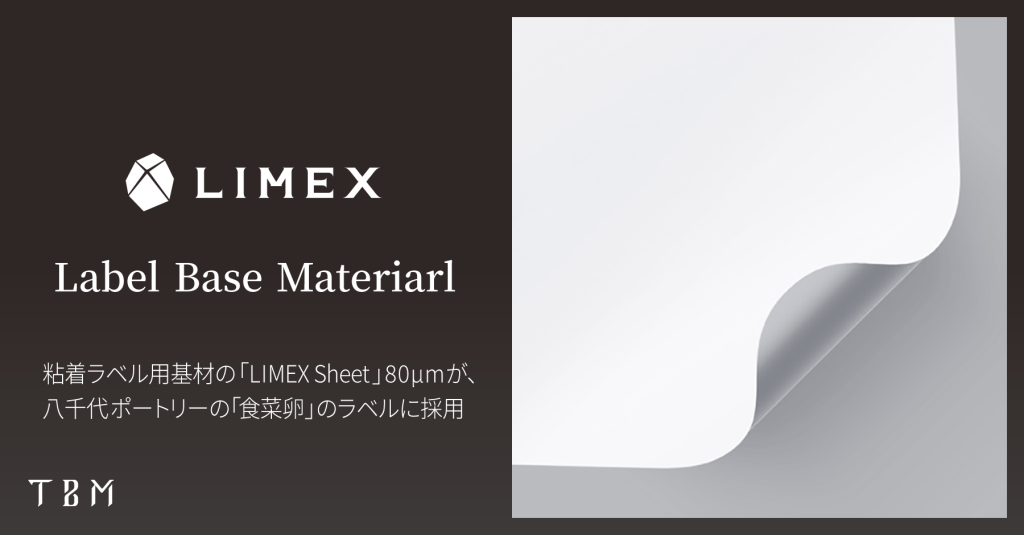プレスリリース
- LIMEX
粘着ラベル用基材の「LIMEX Sheet」80μmが、 八千代ポートリーの看板商品「食菜卵」のラベルに採用
~石油由来プラスチック、CO2削減に貢献できる環境性能を評価~

株式会社TBM(本社:東京都千代田区、代表取締役CEO:山﨑敦義、以下TBM)の石灰石を主原料とする「LIMEX Sheet」が、株式会社八千代ポートリー(所在地:神奈川県横浜市、代表取締役:笠原政利、以下八千代ポートリー)の看板商品「食菜卵」のラベル基材に採用されたことをお知らせいたします。なお本ラベルは、シール・ラベル、フィルム製品、紙器パッケージ、販促ツールまでをワンストップで製造する大阪シーリング印刷株式会社(本社:大阪府大阪市、代表取締役社長:松口正)によって製造されます。
粘着ラベル用基材のLIMEX Sheet 80μmは、表面に印刷可能なインク受理層が塗工されており、裏面には粘着剤塗工が可能です。LIMEX Sheetは、ラベル用途として一般的に用いられるPP(ポリプロピレン)やPET(ポリエチレンテフタレート)シート等の合成紙と比較し、石油由来プラスチック使用量とライフサイクル全体でのCO2を含む温室効果ガス排出量を削減することができます。また、紙製ラベルと比較し、製品の原料に木材パルプを一切使用せず、製造時の水使用量を大幅に削減できるため、森林と水資源の保全に貢献できます。
「自然とともに歩む」を企業理念に掲げる八千代ポートリーは、循環型農業をはじめ持続可能な社会の実現に向けた取り組みを推進している中で、ラベル基材としてのLIMEX Sheetの環境性能を評価いただき、今回の採用に至りました。八千代ポートリーの全商品のラベルを、LIMEX Sheetを基材に使用したラベルへ切り替えた場合、石油由来プラスチックの使用量を年間で約9トン、 CO2を含む温室効果ガス排出量を年間で約104トン削減できる効果*1が見込まれます。
*1 2022年の八千代ポートリーの販売実績に基づくTBMによる環境負荷の算定(原材料調達・シート製造・処分工程を対象とするライフサイクルアセスメント)より。参考値であり保証値ではありません。製造条件によって変動の可能性があります。
■ LIMEX Sheetの特長
LIMEX Sheetは、溶融状態の複合体であるLIMEX(炭酸カルシウム等無機物を50%以上含む、無機フィラー分散系の複合素材)をTダイから押出し、シート状に成形したのち、延伸加工によってシート内部に白さや軽さを生み出す空孔構造を形成しながら製造します。LIMEX Sheetを製造している白石工場と多賀城工場は、実質「100%再生可能エネルギー」「CO2排出係数ゼロ」の電力を使用しています。
※ラベル印刷に使用されるUVインキを使った凸版印刷、オフセット印刷等に対応しております。
・ 石油由来プラスチック使用量削減と、水や森林資源の保全
一般的な合成紙と比べ、石油由来プラスチックの使用量を抑え、CO2を含む温室効果ガスの排出を抑えられます。また、紙と比較し、原料に木材パルプを一切使用せず、製造時に水をほぼ使用しません。
・ 安定した価格
LIMEX Sheet 80μmの主原料である石灰石は、地球上に豊富に存在する資源で、日本国内においても自給自足が可能なため、価格の変動が少なく、安定した価格での原料調達・生産ができます。
・優れた耐久性と耐水性
紙と比較し、耐久性と耐水性に優れているため、水滴の付着が想定される製品の粘着ラベル用途に適しています。
LIMEX Sheetについて詳細はこちら:https://tb-m.com/products/products-sheet/
